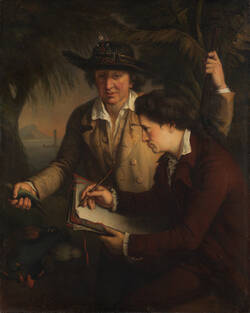Further Media
In 1768, the legendary British navigator James Cook (1728–1779), then a forty-year-old lieutenant, set out on his first circumnavigation of the globe – into the blue, since one-third of the world had not yet been mapped. Less than twelve years later, thanks to Cook’s three expeditions, the main coastlines of the Pacific Ocean had been mapped, from the Bering Strait to the South Pole, from Alaska to Tasmania. Large islands like Aotearoa/New Zealand and New Caledonia appeared on European maps, as did the coastlines of Australia, the Society Islands around Tahiti and the Marquesas chain, the Tonga group and the New Hebrides, the Tuamotus and the islands of Hawai'i. The captain and commander comments, “Ambition leads me not only farther than any other man has been before me, but as far as I think it possible for man to go.”
Cook’s rise from Yorkshire day laborer’s child to the most famous navigator of the 18th century is anything but typical. He earned his spurs as a highly skilled cartographer, starting with Canada's St. Lawrence River in 1758. However, his three voyages around the world became legendary. On Cook’s first circumnavigation (1769–1771) to observe Venus passing in front of the sun in Tahiti, he crossed the Torres Strait between Australia and New Guinea and was the first European to land in Aotearoa, New Zealand. James Cook is of particular importance to the history of British exploration. Until Cook’s landing at Botany Bay (now Sydney) on April 28, 1770, no European had set foot on Australian soil.
Cook’s second circumnavigation of the globe (1772–1775) is considered one of the greatest voyages of discovery by humankind. Not only did he circumnavigate the South Pole, the Briton and his crew were finally able to prove that there was no fertile continent in the Antarctic latitudes, the ominous Terra Australis Incognita. The voyage was of particular significance because with New Caledonia, the New Hebrides (now Vanuatu) and many smaller islands, far more geographical discoveries were made than on Cook's first voyage. For the first time, he was able to use an accurate timepiece, Kendall's chronometer, to determine longitudes accurately, allowing him to place newly discovered coastlines on European maps – a milestone for European seafaring.
On Cook’s third voyage around the world (1776–1780) to test the navigability of the Northwest Passage between the Pacific and Atlantic Oceans in North America, the British navigator not only proved its impassability but also discovered the islands of Hawai'i. Cook’s voyages were also marked by the Enlightenment, with naturalists including the Germans Johann Reinhold Forster and Georg Forster, who scientifically explored unknown islands and discovered a wealth of new plant and animal species. They were especially interested in the people of Oceania and acquired hundreds of their cultural artifacts.
